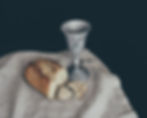Holy Week at Mildmay in 2023
- Apr 6, 2023
- 3 min read

Come feast at this table, God’s banquet now is spread,
With bread of life and saving cup our hunger now is fed. God in an Apron
(Macrina Wiederkehr)
Holy Thursday
Supper was special that night. There was both a heaviness and a holiness hanging in the air. We couldn’t explain the mood. It was sacred, yet sorrowful. Gathered around that table, eating that solemn, holy meal seemed to us the most important meal we had ever sat down to eat.’
Reading John 13:2-5
They were at supper,
and the devil had already put it into the mind of Judas Iscariot, son of Simon, to betray him.
Jesus knew that the Father had put everything into his hands, and that he had come from God and was returning to God.
He got up from the table, removed his outer garment and, taking a towel, wrapped it round his waist.
He then poured water into a basin and began to wash the disciples’ feet and to wipe them with the towel he was wearing

PS.
“There are so many feet to wash,”
I keep saying.
“No.” I hear God’s voice resounding through the years.
“There are only My feet. What you do for them, you do for Me.
Good Friday

Today, at Mildmay, we hope to join the ‘locals’ for the ‘Witness Walk’ following the cross to the Baptist Church, Shoreditch Church, and the Catholic Church in Hoxton, followed by tea with hot cross buns.
As Christians, we contemplate the cross of Christ! This is the day when Christians remember the final journey of Christ to Calvary. There are no words but simply silent contemplation of the above words, with hope in our hearts.
Sister Bernie
Mildmay Chaplain
The Passion of St. John
Each year on Good Friday, the Passion of Jesus, according to John, is read. John’s Gospel was written later than the others, perhaps 70 years after Jesus died, and this gave John time to reflect upon Jesus’ death and highlight several aspects that are not as evident in the other Gospels.
The Power of the Cross – Good Friday
Good Friday is all about the transforming power of suffering love. It takes two pieces of wood to make a cross. That is important for us as we venerate the cross this Good Friday. God so loved the world that he sent his only son to die for us. Beaten, laughed at, ridiculed and tortured – He accepted it all out of love for us.
Acceptance of God’s Love
The part of the cross where the two arms meet is a juncture which represents the call to love ourselves. Sometimes that is where we fail the most. To love one’s self is also a part of the Great Commandment that Jesus gave to us. To forgive ourselves for the mistakes that we have made, to accept ourselves as we are, and to be able to accept God’s infinite love for us. It is our response to God’s love in Jesus and completes the cross.
We adore you, O Christ, and praise you because by the holy Cross, you have redeemed the world.
Amen!
(Dublin Diocesan Liturgical Resources)
Sister Bernie
Mildmay Chaplain
Easter Sunday

Today we have arrived at Easter Sunday. Thank you for journeying with us during Lent and especially during Holy Week.
Everyone at Mildmay wishes our friends, our donors and supporters, and our pop-in-now-and-again followers a very happy Easter!
Draw Us Forth
Draw us forth, God of all creation. Draw us forward and away from limited certainty
into the immense world of your love.
Give us the capacity to even for a moment taste the richness of the feast you give us. Give us the peace to live with uncertainty, with questions, with doubts.
Help us to experience the resurrection anew with open wonder and an increasing ability to see you in the people of Easter.
- Author Unknown
Top banner image credit: Debby Hudson
Pilgrims at the Garden Tomb, Jerusalem, Israel, by Alex-David Baldi
Discovered in the 19th century, the Garden Tomb, north of Jerusalem’s Old City, was initially proposed as the real site of Jesus’ burial instead of the traditional spot inside the Church of the Holy Sepulchre. Supporters pointed out that the shape of a rock nearby resembled a skull, i.e. the Golgotha mentioned in the Gospels. Recent research, however, has disproven any theory that this could be Jesus’ real tomb. Its worth lies rather in its evocative atmosphere and physical similarity to Jesus’ original burial place, which in turn draws thousands of pilgrims every year. As shown in this photo, pilgrims like entering the empty tomb to recreate the experience felt by the first women and apostles who discovered the body of Jesus had vanished from the tomb.







